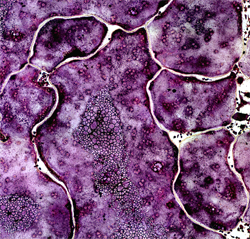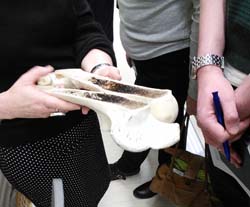The Life and Times of Bone

The importance of bone as a living and dynamic organ system that serves diverse essential roles beyond structure in the vertebrate body is not a widespread notion in the popular imagination. The object of this project is to affect change in public perception about how the bone they observe in a museum comes to be and the biological processes that create it.
I am planning a series of public-facing events in The Hunterian Museum, incorporating a variety of display methods and active visitor involvement. The first of these took place under the banner of the Glasgow Science Festival in June 2015, attracting interest from visitors of all ages.
The objects currently on permanent display in the museum, such as ‘Dr William Hunter’s medical collection’ or the objects demonstrating ‘Vertebrate Evolution’, will provide inspiration for museum-based activities. Animal bone specimens from divergent species will serve as tactile objects demonstrating evolutionary conservation and adaptation. Healthy and disease states of bones will be explained in a biological context, with reference to etiological, epidemiological and historical contexts relevant with artefacts displayed in the museum. A digital light microscope with built-in display will allow guests to see actual fixed bone cells – osteoblasts and osteoclasts. 3-D printed models will be produced to demonstrate its architectural principles. High-quality moving animations of bone cells in action will be shown on a television display. The events will draw on the historic collections, while also presenting the potential benefits of current research.
 Activities will include a bone quiz focussing on museum exhibits, encouraging the public to speculate about the biological processes resulting in the specific architecture of the object.
Activities will include a bone quiz focussing on museum exhibits, encouraging the public to speculate about the biological processes resulting in the specific architecture of the object.
Intended outcomes of the project include: education and outreach in bone biology using the latest multimedia, a renewed perspective and appreciation of extant objects in the collection, dissemination of current research.
Interested to learn more about bones? Check out this series of programmes on BBC Four, The Secrets of Bones
Hussain Jaffery, 2nd year PhD, Molecular Biology /Osteoimmunology
@Hussain_Jaffery - a personal account which will give insight into the project and PhD progress

